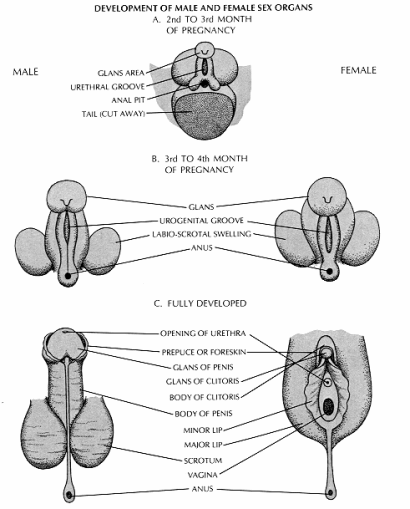|
1.1.1 THE PRIMARY SEXUAL CHARACTERISTICS
The sex organs are the most obvious sexual characteristic. They are also the only external sign of whether a newborn baby is a boy or a girl. However, while the male and female sex organs are very different in appearance, they are similar in origin and structure. In fact, they develop from the same embryonic cell mass. The difference comes about only gradually during the baby's growth before birth. (Also see "Pregnancy.") The sex organs do not become fully functional until after puberty when, under the influence of certain hormones, they finally complete their growth. (Also see "The Role of Hormones.")
The Male
In the first weeks after conception, the male as well as the female embryo is a tiny organism without recognizable human features. However, it does have a primitive head and limb buds which begin to grow into real arms and legs. The embryo further possesses a ridge of tissue which is destined to develop into sex organs. Indeed, the first beginnings of sex glands or gonads can already be found, but, at this point they are still sexually undifferentiated, i.e., they are the same for both sexes. Externally, a hump (suggestive of the males with a groove (suggestive of the female) can be observed at the spot where the future sex organs will grow. As the male embryo slowly begins to look more human toward the end of the third month of its life, the hitherto undifferentiated gonads develop into testicles. The external hump assumes the shape of a penis, and the groove closes. (As evidence of this original groove, each male retains a pink scar line running down the underside of his penis all the way from the glans to the anus.) Two patches of skin on either side of the hump begin to form the scrotum. (In the female, they become the major lips to the vulva.)
As the embryo grows into the fetus, the sex organs continue to develop together with the entire body. Between the seventh and ninth months the testicles normally descend into the scrotum.
In the period between birth and puberty, the sex organs do not show any dramatic further development. However, during the ages of 12 to 17 boys normally experience a noticeable growth of their sex organs and eventually their first ejaculation of semen. They will also notice that some hair (called pubic hair) begins to grow at the base of the penis. All of this indicates that the sex organs are completing their maturation. (For further details, see "The Male Sex Organs."}
The Female
Both the female and the male embryo remain sexually undifferentiated for the first few weeks of their lives. They do possess the beginnings of sex glands or gonads, but these beginnings are the same for both sexes. Just as the male, the female also shows a hump and a groove at the spot where the future external sex organs will develop. However, in her case the hump
 |
develops into the clitoris while the groove remains open, forming the minor lips and the vestibule of the vulva. Two patches of skin on either side develop into the major lips. (In the male, they develop into the scrolum.) The original gonadal structures which develop into testicles in the male evolve into ovaries in the female.
Between her birth and puberty, a girl's sex organs do not undergo any dramatic further development. However, during the ages of 11 to 13 some hair (pubic hair) will begin to grow on her vulva, and her first menstruation can normally be expected at that time. These signs indicate that she is close to sexual maturation. (For further details, see "The Female Sex Organs.")
|

